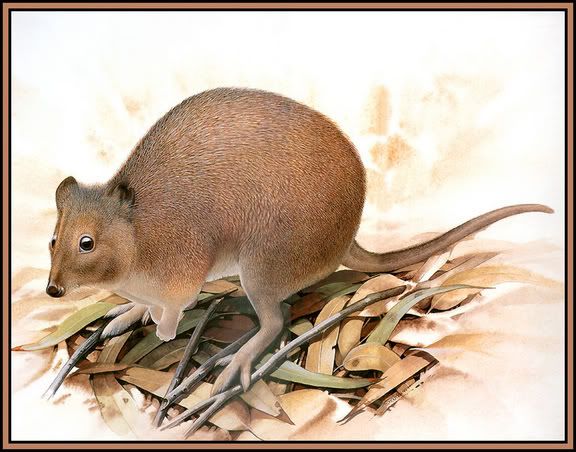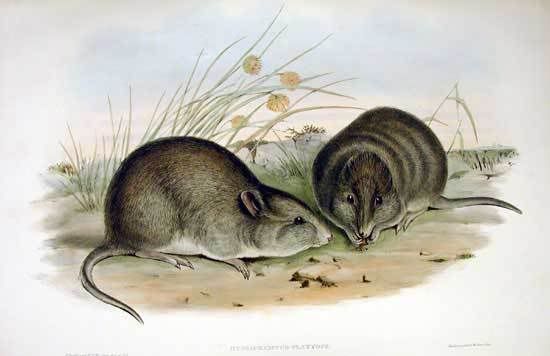|
|
Post by another specialist on Dec 5, 2006 10:53:00 GMT
BROAD-FACED POTOROO Potorous platyops The broad-faced potoroo is thought to have been extinct since around 1875. |
|
|
|
Post by another specialist on Dec 5, 2006 11:03:31 GMT
|
|
|
|
Post by another specialist on Dec 5, 2006 11:20:01 GMT
 broadfaced potoroo gap in nature |
|
|
|
Post by another specialist on Dec 5, 2006 11:25:08 GMT
The extinct Broad-faced Potoroo (Potorous platyops) was first collected in 1839 and described by John Gould in 1844, but even then it was rare and only a handful of specimens were ever collected, the last in 1875. Subfossil remains indicate that it originally had an extensive distribution from the semi-arid coastal districts of South Australia to the Western Australian coast, and possibly as far north as North West Cape. The habits of the Broad-faced Potoroo are almost entirely unknown. It is clear that it avoided the fertile forested areas that its relatives the Long-nosed and Long-footed Potoroos inhabit. It is unusual amongst recently extinct Australian vertebrates in that it appears to have declined significantly before European settlement of Australia. Preserved specimens indicate that it was smaller than the other potoroos at around 24 cm long with an 18 cm tail. The coat was grizzled grey above and dirty white below, the body similar in shape to that of a large rat. The ears were small and rounded, the muzzle fairly short, and the cheeks notably puffy. en.wikipedia.org/wiki/Broad-faced_Potoroo |
|
|
|
Post by another specialist on Dec 5, 2006 11:34:01 GMT
|
|
|
|
Post by another specialist on Sept 4, 2007 20:09:25 GMT
|
|
|
|
Post by another specialist on Sept 4, 2007 20:14:59 GMT
|
|
|
|
Post by another specialist on Sept 10, 2007 18:47:00 GMT
Australian Mammal Gould Print Images John Gould print image of the Broad-faced Potoroo Potorous platyops (formerly known as Hypsiprymnus platyops)  Photo from "Mammals of Australia", Vol. II Plate 70 Part of the 3 Volumes by John Gould, F.R.S. Published by the author, 26 Charlotte Street, Bedford Square, London, 1863 Reproduction Photo by Marnie Rawlinson, Cathy Accurso and Ken Walker © Museum Victoria www.museum.vic.gov.au/ |
|
|
|
Post by another specialist on Sept 10, 2007 18:52:35 GMT
|
|
|
|
Post by another specialist on Jan 5, 2008 17:40:26 GMT
|
|
|
|
Post by another specialist on Jan 6, 2008 21:36:00 GMT
|
|
|
|
Post by thomasw on Feb 25, 2008 17:28:44 GMT
|
|
|
|
Post by another specialist on Feb 25, 2008 18:58:43 GMT
|
|
|
|
Post by another specialist on Jul 9, 2008 3:54:08 GMT
Potorous platyops Author: Gould, 1844. Citation: Proc. Zool. Soc. Lond., 1844: 103. Common Name: Broad-faced Potoroo Type Locality: Australia, Western Australia, Swan River, L. Walyormouring. Distribution: Formerly SW Western Australia and Kangaroo Isl, South Australia. Status: IUCN – Extinct. Comments: Probably extinct (Ride, 1970:199); there are no records after 1875. www.bucknell.edu/msw3/browse.asp?s=y&id=11000189 |
|
|
|
Post by another specialist on Oct 11, 2008 9:51:59 GMT
Taxonomy [top] Kingdom Phylum Class Order Family ANIMALIA CHORDATA MAMMALIA DIPROTODONTIA POTOROIDAE Scientific Name: Potorous platyops Species Authority Infra-specific Authority: (Gould, 1844) Common Name/s: English – Broad-faced Potoroo Assessment Information [top] Red List Category & Criteria: Extinct ver 3.1 Year Assessed: 2008 Assessor/s Australasian Mammal Assessment Workshop Evaluator/s: Lamoreux, J. & Hilton-Taylor, C. (Global Mammal Assessment Team) Justification: Listed as Extinct because it has not been recorded in more than 100 years despite extensive surveys. History: 1996 – Extinct (Baillie and Groombridge 1996) 1994 – Extinct (Groombridge 1994) 1990 – Extinct (IUCN 1990) 1988 – Extinct (IUCN Conservation Monitoring Centre 1988) 1986 – Extinct (IUCN Conservation Monitoring Centre 1986) 1982 – Extinct (Thornback and Jenkins 1982) Geographic Range [top] Range Description: This species was endemic to Australia, where it once ranged from coastal South Australia westwards to Albany, Western Australia and northwards through the wheatbelt of Western Australia, at least as far north as the Geraldton region (Kitchener and Friend 2008). Countries: Regionally extinct: Australia Population [top] Population: It is presumed to be extinct. The last known record was in the 1875 when five specimens were sold to the National Museum in Victoria (Kitchener and Friend 2008). Appropriate, targeted surveys have not recorded this species since. Habitat and Ecology [top] Habitat and Ecology: The species is very poorly known. It is not believed to have occurred in forested areas (Kitchener and Friend 2008). Systems: Terrestrial Threats [top] Major Threat(s): Presumably this species declined through feral cats and possibly disease. Conservation Actions [top] Conservation Actions: There are no conservation measures pertaining to this species. www.iucnredlist.org/details/18103 |
|
|
|
Post by surroundx on Dec 12, 2012 6:13:13 GMT
"Potorous morgani Finlayson, 1928. Trans. Rov. Sue. S. Aust., 62 (I): 132-140, pis. v-vii. Synlypes: SAM. P. 168, skull and partial skeleton. SAM. P.3413, skull. Locality: Kelly Hill Caves, Kangaroo Island. Formation: Cave earth. Age: Recent. Collector: Miss Edith May (P168). February 1926. Dr. A. M. Morgan (P34I3). 1927 (?). Remarks — Ride (1970: 224) has synonymised this species with P. plalyops. an extant species in Western Australia. Sec also Butler and Merrilees (1971) for further discussion. The
species may still live on Kangaroo Island. " Source: archive.org/stream/RecordsSouthAus17Sout/RecordsSouthAus17Sout_djvu.txt |
|
|
|
Post by surroundx on Dec 12, 2012 15:44:55 GMT
|
|
|
|
Post by surroundx on May 8, 2014 14:27:01 GMT
I have this paper if anybody wants a copy. PM me: Walshe, Keryn. (2014). Archaeological Evidence for a Sealer's and Wallaby Hunter's Skinning Site on Kangaroo Island, South Australia. The Journal of Island and Coastal Archaeology 9(1): 130-143. [ Abstract] |
|
|
|
Post by amongthylacines on May 8, 2014 19:42:35 GMT
Very interesting. Never knew the broad-faced potoroo lived on Kangaroo island (though I should have known). But this paper (the abstract) says that this potoroo was 'wallaby sized'.
Well, imo, that's simply not true or maybe the Kangaroo island specimens were 'giant sized' wich is of course possible but -again imo- quite unlikely.
Still Kangaroo island must have been a wonderful Eden-like haven before homo sapiens set foot (first the Aboriginals (oh how they lived in harmony with nature (yeah right) and then the sealers)
Thanx for sharing surroundx
|
|
|
|
Post by surroundx on May 11, 2014 5:31:47 GMT
Very interesting. Never knew the broad-faced potoroo lived on Kangaroo island (though I should have known). But this paper (the abstract) says that this potoroo was 'wallaby sized'. Well, imo, that's simply not true or maybe the Kangaroo island specimens were 'giant sized' wich is of course possible but -again imo- quite unlikely. Still Kangaroo island must have been a wonderful Eden-like haven before homo sapiens set foot (first the Aboriginals (oh how they lived in harmony with nature (yeah right) and then the sealers) Another species of Potorous, P. morgani, was described from two subfossil skulls found in Kelly Hill Caves, Kangaroo Island, South Australia (Finlayson, 1938). However, this species was later synonimized with P. platyops by (Ride, 1970:224), where it has since stayed. Additional specimens from the same site by Matthew McDowell, as well as from Cape du Couedic and Seton Rockshelter have been excavated (K. Walshe, pers. comm. May 2014). More recent remains from KI have been reported by (Walshe, 2014) which show that it was present on KI post-European contact, and became extinct due to hunting pressure (K. Walshe, pers. comm. April 2014). The species may therefore be mentioned in early KI literature, however I know of no such mention. References:Finlayson, H. H. (1938). On a new species of Potorous (Marsupialia) from a cave deposit on Kangaroo Island, South Australia. Trans. R. Soc. S. Aust. 62: 132-140. Ride, W. D. L. (1970). A guide to the Native Mammals of Australia. Melbourne, etc.: Oxford University Press. 249 pp. Walshe, Keryn. (2014). Archaeological Evidence for a Sealer's and Wallaby Hunter's Skinning Site on Kangaroo Island, South Australia. The Journal of Island and Coastal Archaeology 9(1): 130-143. (I have this paper if you want a copy?) |
|